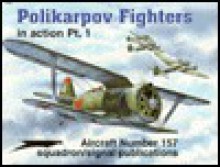
This book provides a fairly comprehensive history of the first generation of Polikarpov fighter planes -- all biplanes --- produced by the Soviet Union during the 1930s, which came into being in response to Moscow's decision to modernize the Soviet air force and aviation industry in the Soviet Union. Many of these fighters (e.g. the I-15 and the I-152) saw combat in the Spanish Civil War, in the Battles of Khalkhin Gol (fought between the Soviet Union and Japan from May to September 1939), the Sino-Japanese War (with the Chinese Air Force), and during the early stages of World War II.
The Polikarpov fighters, when they first arrived on the scene, were among the most advanced aircraft in the world. But by the time Europe was on the eve of war in 1939, these Soviet fighters had become obsolete, due to the widespread adoption of the monoplane fighter by a majority of the world's modern air forces. The day of the biplane was now passé. Nevertheless, Stalin insisted that a more advanced biplane fighter be developed. Thus was born the Polikarpov I-153, which had a retractable landing gear, and boasted a higher speed, as well as heavier armament, than its predecessors. Though a robust fighter, the I-153 proved to be unsuitable for fighter-vs-fighter combat during the German invasion of the Soviet Union in June 1941 and was largely relegated to the ground attack role until it was phased out of service in 1943.
This is a fantastic book, with many photos and a page containing illustrations of the various Polikapov fighters (1st generation) in their various uses from the Spanish Civil War, the Sino-Japanese War, to World War II.


 Log in with Facebook
Log in with Facebook 









